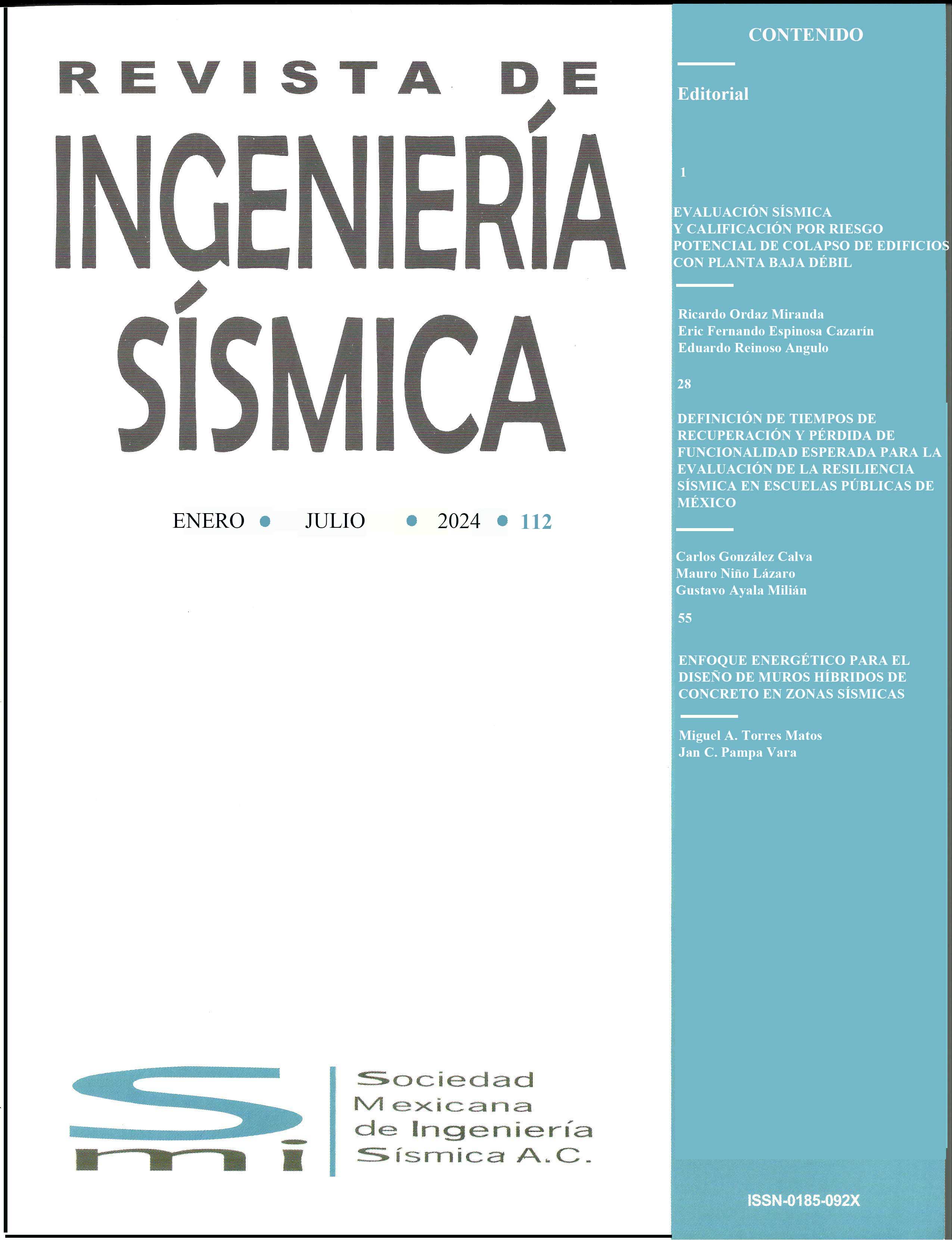ABOUT HOW A VULNERABLE BUILDING RESISTED THE 1967 CARACAS EARTHQUAKE WITHOUT DAMAGE
DOI:
https://doi.org/10.18867/ris.106.585Keywords:
1967 earthquake, Belaire building, nonlinear dynamic analysis, Los Palos GrandesAbstract
The 1967 earthquake caused damage in 48% of buildings located in the Los Palos Grandes-Altamira area in Caracas. The surprising performance of a highly vulnerable reinforced concrete frame building is analyzed, which did not suffer damage during the earthquake despite not having beams in one direction and having a weak floor condition at its lower level due to the absence of walls. Four pairs of accelerograms representative of movement in the thick sediment zone were generated, considering that the motion has an intensity in the North-South direction that is approximately three times greater than the East-West direction. Mathematical models adjusted to environmental vibration measurements were developed. The response of the building was determined by means of non-linear dynamic analysis, achieving a performance similar to that observed, highlighting a significant variation in the response from one accelerogram to another. The influence of the particular orientation of this building is highlighted; the lack of damage was due to the favorable coincidence between the strong direction of greater rigidity and resistance of the structure and the direction of greater intensity of ground motion. The performance of the building was evaluated if it had been built rotated 90°, obtaining significant structural damage, which emphasizes the need to reinforce similar old buildings that were not damaged.
Downloads
References
ASCE (2017). Seismic rehabilitation of existing buildings. ASCE 41. American Society of Civil Engineers. Virginia, EEUU. DOI: 10.1061/9780784408841
Bozorgnia, Y, N Abrahamson, L A Atik, T Ancheta, G Atkinson, J Baker, A Baltay, D Boore, K Campbell, B Chiou, R Darragh, S Day, J Donahue, R Graves, N Gregor, T Hanks, I Idriss, R Kamai, T Kishida, A Kottke, S Mahin, S Rezaeian, B Rowshandel, E Seyhan, S Shahi, T Shantz, W Silva, P Spudich, J Stewart, J Watson-Lamprey, K Wooddell y R Youngs (2014). “NGA-West2 Research Project”. Earthquake Spectra, Vol. 30, No. 3, pp. 973-987. DOI: 10.1193/072113EQS209M
COVENIN 1753 (2006). Norma Venezolana: Proyecto y construcción de obras en concreto estructural. FONDONORMA Caracas, Venezuela.
CPES (1978). Segunda fase del estudio del sismo ocurrido en Caracas el 29 de julio de 1967 (Vol A y Vol. B). Comisión Presidencial para el Estudio del Sismo, Caracas, FUNVISIS.
FEMA (2020). Hazus earthquake model technical manual. Federal Emergency Management Agency (FEMA). Washington D.C., USA. https://www.fema.gov/sites/default/files/2020-10/fema_hazus_earthquake_technical_manual_4-2.pdf
Ghobarah, A (2004). “On drift limits associated with different damage levels”. International Workshop on Performance-Based Seismic Design. Department of Civil Engineering, McMaster University, Ontario, Canada.
Grases, J (1968). “El sismo de Caracas de 1967. “Estudios orientados hacia su interpretación a partir del comportamiento de estructuras”. Boletín Técnico IMME, 6 (23-24), 3-125.
Guerrero A y O A López (2019). “Espectro de respuesta del sismo de Caracas de 1967”. Rev. Téc. Ing. Univ. Zulia. Vol. 42, No. 3, 2019, Septiembre-Diciembre, pp. 104-151. DOI: 10.22209/rt.v42n3a01
Guerrero, A (2018). “Desempeño de edificios afectados por el sismo de Caracas de 1967 en la zona de Los Palos Grandes- Altamira”. Trabajo de Grado de M. Sc., Tutor: Oscar A. López.
Luchsinger, J (1972). “Contribución de los elementos de tabiquería de arcilla en la respuesta de estructuras sometidas a cargas sísmicas”. Boletín Técnico del IMME (N 39-400).
PEER. Pacific Earhquake Ground Motion Database. Consultada en octubre de 2017. https://ngawest2.berkeley.edu
Robson, G R, L Canales y L Esteva (1968). “The Caracas earthquake of 29 July 1967: Venezuela”, Serial Nº 571/BMS.RD/AVS. UNESCO. Paris. https://unesdoc.unesco.org/ark:/48223/pf0000015201_eng
Schmitz, M, J Hernández, C Morales, J Domínguez, V Rocabado, M Vallée, y otros (2011). “Principales resultados y recomendaciones del proyecto de microzonificación sísmica en Caracas y estrategias para su implementación”. Rev. Fac. de Ing. U.C.V., 26 (2), 113-128. Recuperado el 27 de enero de 2021, de http://ve.scielo.org/scielo.php?script=sci_arttext&pid=S0798-40652011000200011&lng=es&tlng=en
Skinner, R I (1969). “Damage mechanisms and design lessons from Caracas”. Proceedings of the Fourth WCEE, Vol. 3, J-2. Santiago de Chile. 124 a 136.
Sozen, M A, P C Jennings, R Matthiensen, y G W Housner (1968). “Engineering report on the Caracas earthquake of July 29, 1967”. Washington National Academy of Sciences. 116.
Urich, A y O A López (2006). “Importancia de la orientación de los planos resistentes en el desempeño sísmico de edificios en Los Palos Grandes 1967”. VIII CONVESIS, Valencia.
Urich, A (2013). “Desempeño de edificios y acciones sísmicas en los Palos Grandes 1967”. Tesis de M.Sc. Tutor: Oscar A. López. Universidad Central de Venezuela. Fac. de Ingeniería.






